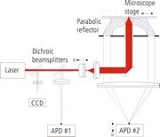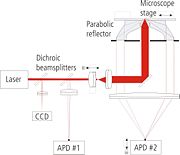
SAF Microscopy
Encyclopedia
Supercritical Angle Fluorescence Microscopy (SAF) is a technique to detect and characterize fluorescent species (proteins, biomolecules, pharmaceuticals, etc.) and their behaviour very close or even adsorbed
or linked at surfaces. The method is able to observe molecules in a distance of less than 100 to 0 nanometer from the surface even in presence of high concentrations of fluorescent species around. Using an aspheric lens for excitation of a sample with laser light, fluorescence
emitted by the specimen is collected above the critical angle
of total internal reflection
selectively and directed by a parabolic optics onto a detector. The method was invented in 1998 in the laboratories of Stefan Seeger
at University of Regensburg
/Germany and later at University of Zurich
/Switzerland.
tube or avalanche photodiode
detector. It is also possible to arrange SAF elements as arrays, and image the output onto a CCD, allowing the detection of multiple analytes.
 .
.
Adsorption
Adsorption is the adhesion of atoms, ions, biomolecules or molecules of gas, liquid, or dissolved solids to a surface. This process creates a film of the adsorbate on the surface of the adsorbent. It differs from absorption, in which a fluid permeates or is dissolved by a liquid or solid...
or linked at surfaces. The method is able to observe molecules in a distance of less than 100 to 0 nanometer from the surface even in presence of high concentrations of fluorescent species around. Using an aspheric lens for excitation of a sample with laser light, fluorescence
Fluorescence
Fluorescence is the emission of light by a substance that has absorbed light or other electromagnetic radiation of a different wavelength. It is a form of luminescence. In most cases, emitted light has a longer wavelength, and therefore lower energy, than the absorbed radiation...
emitted by the specimen is collected above the critical angle
Critical angle
Critical angle can refer to:*Critical angle the angle of incidence above which total internal reflection occurs*Critical angle of attack, in aerodynamics; the angle of attack which produces the maximum lift coefficient...
of total internal reflection
Total internal reflection
Total internal reflection is an optical phenomenon that happens when a ray of light strikes a medium boundary at an angle larger than a particular critical angle with respect to the normal to the surface. If the refractive index is lower on the other side of the boundary and the incident angle is...
selectively and directed by a parabolic optics onto a detector. The method was invented in 1998 in the laboratories of Stefan Seeger
Stefan Seeger
Stefan Seeger is a German chemist and professor at the University of Zurich in Switzerland.Stefan Seeger is a member of the German Society of Chemists, the Swiss Society of Chemists, the American Chemical Society, the Optical Society of America, a board member of the Paul-Karrer-foundation and...
at University of Regensburg
University of Regensburg
The University of Regensburg is a public research university located in the medieval city of Regensburg, Bavaria, a city that is listed as a UNESCO World Heritage Site. The university was founded on July 18, 1962 by the Landtag of Bavaria as the fourth full-fledged university in Bavaria...
/Germany and later at University of Zurich
University of Zurich
The University of Zurich , located in the city of Zurich, is the largest university in Switzerland, with over 25,000 students. It was founded in 1833 from the existing colleges of theology, law, medicine and a new faculty of philosophy....
/Switzerland.
SAF Microscopy Principle
The principle how SAF Microscopy works is as follows: A fluorescent specimen does not emit fluorescence isotropically when it comes close to a surface, but approximately 70% of the fluorescence emitted is directed into the solid phase. Here, the main part enters the solid body above the critical angle. When the emitter is located just 200 nm above the surface, fluorescent light entering the solid body above the critical angle is decreased dramatically. Hence, SAF Microscopy is ideally suited to discriminate between molecules and particles at or close to surfaces and all other specimen present in the bulk,.Typical SAF-setup
The typical SAF setup consists of a laser line (typically 450-633 nm), which is reflected into the aspheric lens by a dichroic mirror. The lens focuses the laser beam in the sample, causing the particles to fluoresce. The fluorescent light then passes through a parabolic lens before reaching a detector, typically a photomultiplierPhotomultiplier
Photomultiplier tubes , members of the class of vacuum tubes, and more specifically phototubes, are extremely sensitive detectors of light in the ultraviolet, visible, and near-infrared ranges of the electromagnetic spectrum...
tube or avalanche photodiode
Avalanche photodiode
An avalanche photodiode is a highly sensitive semiconductor electronic device that exploits the photoelectric effect to convert light to electricity. APDs can be thought of as photodetectors that provide a built-in first stage of gain through avalanche multiplication. From a functional standpoint,...
detector. It is also possible to arrange SAF elements as arrays, and image the output onto a CCD, allowing the detection of multiple analytes.


